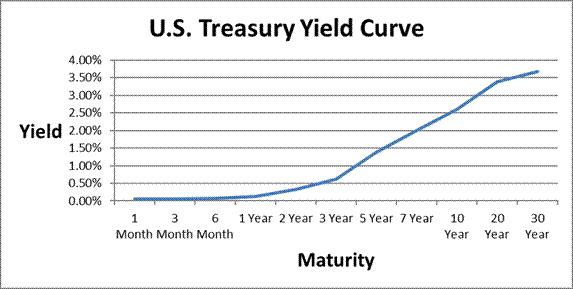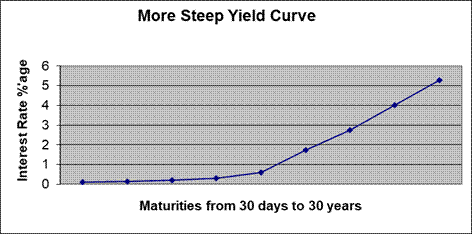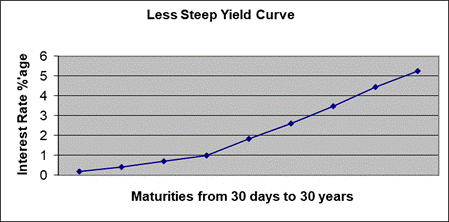What Is a “Yield Curve” and What Does It Mean?
Understand the yield curve’s message: anticipate rate changes, adjust financial decisions, and acknowledge interest rate risks.
The term “yield curve” is often used in discussions of interest rates. At the simplest level, it is just a line on a graph that connects points reflecting current interest rates on bonds with different maturities. It is usually associated with US government bonds. Consider the following example:
Term of US government instrument |
Yield |
1 Month |
0.05% |
3 Month |
0.06% |
6 Month |
0.08% |
1 Year |
0.12% |
2 Year |
0.32% |
3 Year |
0.62% |
5 Year |
1.39% |
7 Year |
2.01% |
10 Year |
2.61% |
20 Year |
3.39% |
30 Year |
3.67% |
With those interest rates, the “yield curve” would look like this:

What does this signify?
US government bonds are fixed rate instruments; that is, once they are issued, they pay a stated amount of interest regardless of whether interest rates go up or down. If rates go up, a potential buyer is naturally willing to pay less than what they would for a bond issued at that time. Since the market for US government bonds is very large and very actively traded, the result is a current price for the bond that reflects the current interest rate environment.
You should also note that the shape of the “yield curve” changes as investors take into account their expectations for future changes in interest rates. If investors think interest rates are going to rise, the “slope” of the yield curve will probably be steeper. Conversely, if their expectation is that rates will fall, the slope will probably be more moderate. Here are some examples:


What does this mean to you?
Most institutions use the interest rates for US government bonds as “benchmarks” for setting interest rates on their deposit and loan products. This is reflected in how they set interest rates on CDs and their loans. In most situations, the interest rates on shorter-term CDs are lower than the rates on longer-term CDs. The interest rates on 30-year mortgages are usually higher than the rates on 15-year mortgages or adjustable rate mortgages.
The professional institutional investors spend large amounts of money and time to gather as much information as possible to make informed decisions about the future direction of interest rates. The result of these efforts is a very efficiently priced market. As an individual, you can probably not “out-guess” them.
The best courses of action are probably just to be more aware of how interest rates can change and to remember to factor “interest rate” risk into your decision-making. When rates rise, bond values fall. When rates fall, bond values rise.